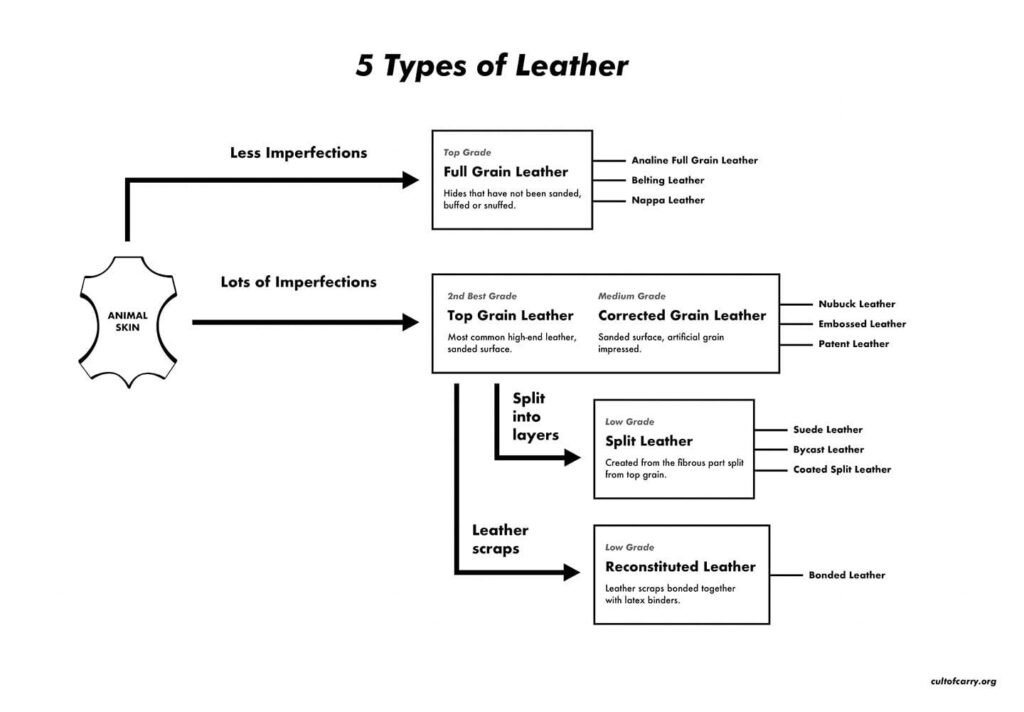Know
Your Leather
At Bearded Dog Leather, we’re passionate about crafting products that stand the test of time. That’s why we exclusively use full grain leather, renowned for its durability and longevity when properly maintained. For us, it’s not just about achieving flawless hides; it’s about prioritizing quality and strength over superficial perfection.
Understanding the nuances of leather types can empower your purchasing decisions:
In the journey from rawhide to exquisite leather, the initial split of the cowhide determines the final product’s quality and purpose. The hide is divided into two sections: the top, containing the highest quality grain, and the bottom, which may undergo further splitting to create different grades.
- Top of the Hide — Full and Top Grain Leathers: Full grain leather retains the entire natural grain, including imperfections, which adds character and allows it to develop a unique patina over time. Top grain leather, though slightly processed for a smoother appearance, maintains durability while sacrificing some natural texture.
- Bottom of the Hide — Split and Genuine Leathers: Split grain leather, such as suede, lacks the natural grain but offers a soft and pliable texture. Genuine leather, while technically authentic, undergoes heavy processing, stripping away natural characteristics and resulting in lower durability and aesthetic appeal.
- Bonded Leather: Contrary to its name, bonded leather is not entirely leather. It’s a composite material made from leather scraps, vinyl, and other substances bonded together. While inexpensive, it lacks the durability and charm of genuine leather.
In fact, alternatives like waxed canvas and vegan leathers often surpass genuine and bonded leather in both durability and quality.
When shopping for leather goods, remember that investing in full grain leather is an investment in longevity. With proper care, full grain leather products become cherished possessions, growing more beautiful with age as they develop that coveted warm patina.
So, whether it’s a wallet, bag, or jacket, choose quality that lasts—a decision you’ll appreciate for years to come.

How to take care of your leather
Now that you’ve invested in one (or more) of our leather products, you will need to know how to take care of your leather to get the maximum life out of it. Harsh sunlight, temperature changes, scratches, and stains can affect its life and longevity. We are all about caring for the leather in a way that lets the life story of the leather—and its carrier—emerge over time.
So, here are 4 simple steps to care for your leather—whether wallet, handbag, bag, or Dopp kit—in a way that honours its story and yours:
1. IF YOUR LEATHER GETS WET, DRY IT
Gently blot (not rub!) excess water as soon as possible and allow the rest to air dry. Do not use a heat source to speed up the drying and do not place the item in the sun. When drying a bag, stuff the inside with newspaper to help the bag hold its shape and to help absorb moisture from the interior.
2. IF YOUR LEATHER GETS TOO DRY, CONDITION IT
Much like your skin, leather needs to be moisturized and cared for to prevent it drying out or cracking. Proper care will help prevent this from happening and protect your leather goods for many years to come.
We offer two types of leather conditioners:
- A clear oil wax with no harsh chemicals which is generally used on chrome tanned leather.
- Our leather balm (manufactured by UltraBee) only contains natural oils and beeswax and is mainly used for vegetable tanned leathers.
Massage the leather conditioner into the leather and use a clean cloth to gently wipe off excess if required.
3. IF YOUR LEATHER GETS DIRTY, CLEAN IT
Start by always handling your leather with clean hands – oil and residue will easily transfer to leather. Every other day, wipe your leather bag with a soft, dry, or slightly damp cloth.
4. IF YOUR LEATHER ISN’T BEING USED, STORE IT
Proper storage is important when caring for leather. Store leather in a space away from heat, humidity, sunlight, and dust – preferably in a fabric (not plastic!) bag and/or box. Air leather bags, jackets, and luggage once every few weeks to prevent mold growth.
When you care for leather properly, it will become more beautiful, rugged, and interesting over time, echoing its adventures—and yours.
Leather Care Products
-
- Out of Stock
Clear Oil Wax
- R150,00
- Read more
-


